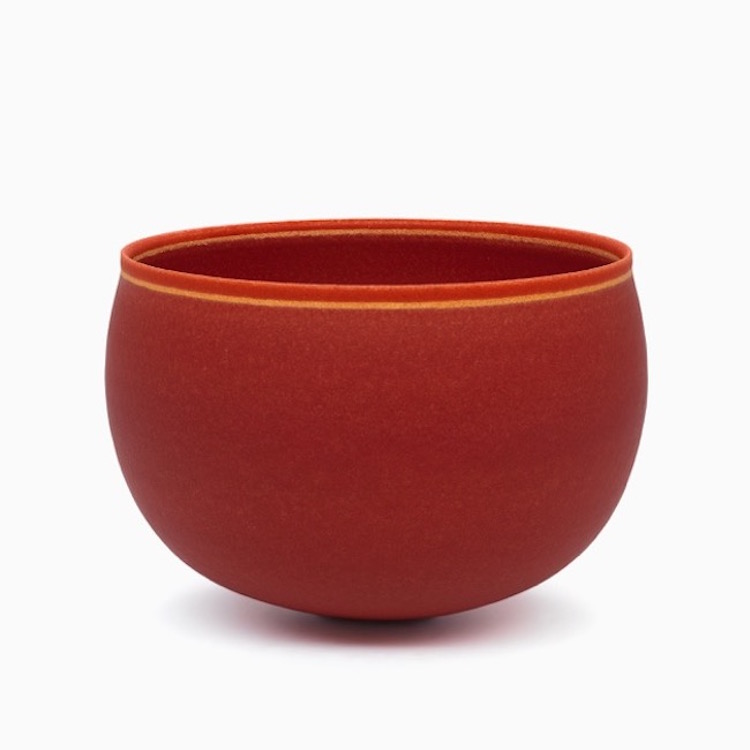BRUSSELS, Belgium — We recently added a handsome catalog of work by Alev Ebüzziya Siesbye to cfile.library. For the occasion, we’d like to draw your attention to the artist’s recent exhibition at the Pierre Marie Giraud gallery (Brussels, May 20 – June 18). The following text is from the gallery, presented here with our edits.
Above image: Alev Ebüzziya Siesbye, Untitled, 2015, 6.1 x 8.1 x 8.1 inches
Alev Ebüzziya Siesbye was born in 1938 in Istanbul of Turkish parents. From 1956 to 1958 she studied sculpture at the Istanbul Academy of Fine Arts, while also attending Füreya’s Ceramic Workshop. She spent two years a production worker in the ceramic factories at Höhr-Grenzhausen, returning to Istanbul in 1960 to work in the Art Workshop of the Eczacibasi Ceramic Factories. In 1963 she moved to Copenhagen, where she worked first for Royal Copenhagen and, since, 1969, she has had her own workshop. She has designed for both Rosenthal and Royal Copenhagen. She now lives and works in Paris.

Alev Ebüzziya Siesbye, Untitled, 2011, ceramic, 5.2 x 9.9 x 9.9 inches
Alev Ebüzziya’s vessels are characterized by their proud stance and pristine outlines. However, they present quite a contrast to the formal diversity of ancient Anatolian ceramics, as they focus and elaborate on subtle variations of a single reductive bowl form. These bowls are curvaceous, thin walled, and wide rimmed. Unlike ancient Anatolian wares, they are made of denser, high-fire, gray-white stoneware, giving strength to their thin walls, and they are built with a combination of complex, wheel-thrown and coil-built techniques. They stand on a tiny, non-visible foot, which lightly lifts the bowls from the surface they stand on, endowing them with a gravity-defying stance. Their ample bodies invite the viewer to contemplate the silence of the space they hold within. In appearance, these streamlined vessels seem much more ethereal and delicate than ancient Anatolian pottery. However, in terms of their spatial containment and purity of form, these minimalistic large bellied volumes relate beautifully to the ample-bodied bowls of the Van-Urmiya and Trans-Caucasian regions, and to the full-bodied Hittite beak-spouted vessels. The minimalistic aesthetics of Ebüzziya’s sculptural vessels has its roots not only in these ancient terracotta works, but also in the great bronze cauldrons of the Urartian and Phrygian periods (9th-7th centuries BCE), the Greco-Persian, Hellenistic and Roman clay, glass, and metal vessels (6th century BCE — 12th century CE), and Seljuk metal wares (12th — 13th century CE), all produced on Anatolian soil.

Alev Ebüzziya Siesbye, Untitled, 2013, ceramic, 9.8 x 11.8 x 11.8 inches

Alev Ebüzziya Siesbye, Untitled, 2014, ceramic, 10.2 x 12.4 x 12.4 inches
While purity of form, where “less is more” is certainly the signature of Ebüzziya’s sculptural style, this approach has not distanced her from developing a very personal and selective surface decoration to complement her forms. Ornamentation of a very subtle kind is an essential feature of Ebüzziya’s visual vocabulary, where it is used to highlight important formal features and to create rhythm. Her bowls are not about transience, but they are the material manifestations of a profound quest for preservation, continuity, and a deep desire “not to forget, but to remember again and again.” In the soundless depths of Ebüzziya’s vessels, where past and present merge, the vibrant soul of ancient Anatolia continues to reverberate with universal appeal in the hearts of people from different horizons, transcending cultures, geographies, and time.
Text (edited) and images courtesy of the gallery.
Do you love or loathe this contemporary ceramic art? Let us know in the comments.

Alev Ebüzziya Siesbye, Untitled, 2008, 8.1 x 11.6 x 11.6 inches

Eternal. Invitations to hold and breathe deeply.